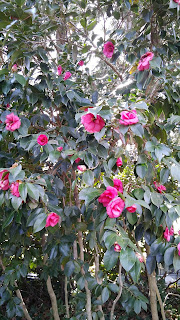 |
| Bodi is allowed in my personal space when he is calm enough to be polite. |
When I try to communicate with horses I have a hard time controlling my "volume," or how intense I make my gestures. A hand raised in front of me just a bit too quickly sends the horse's head away from me, eyes wide. Not standing straight enough means a horse moves closer than I'd like it to and I have to move or move them, when I meant to stop them just outside of my personal bubble.
To make things even more interesting, a different level is needed with every horse. What works with one may be too intense or not intense enough to get the same reaction from another.
 | |
| Aspen hanging out in his new field with a more dominant horse, but one who responds more intensely to body language than Aspen. |
 |
| I greet Aspen. (Photo courtesy of Amy M.) |
In this first photo I wanted to come over and say hello to Aspen without making him leave. Things I noticed in this photo are details like my body posture- leaning forward and slumping a bit, with an arm extended slightly. My hand is offered with the knuckles facing Aspen's nose and the hand in a low, relaxed position. On Aspen's part, his eyes are half-closed, and he has curved his neck around to sniff my hand. Importantly, he brought his face to meet me halfway. I haven't taken up all the space between us with my reach. His ears aren't pricked forward, so he's not super interested in me, but they are flopped slightly to the sides, which means he's relaxed.
The most important part here in getting him to stay is to keep my hand still and not move it to pet his face. SO MANY of my early interactions with horses were me trying to pet their faces. Horses would invariably move their heads away from my hands, sometimes followed by leaving entirely if they were shy or uninterested. I found that waiting in this greeting position for the short span of time it took to complete the greeting process on the horse's terms allowed me to go ahead and pet their shoulder or halter them or pick their feet, etc with less aversion on the horse's part. It made such a difference, just waiting for the horse to finish greeting me and turn their head away (or start shaking me down for treats) on their own.
 |
| Aspen follows me to see what I'm up to. (Photo by Amy M.) |
This time my posture is more bold- my shoulders are relaxed but square. My frame is bigger. I have a purpose for walking over there. However, my head is still lowered. I'd backed away from Aspen while motioning with my hand like I had a lead rope in it and was leading him toward the fence. In the picture Aspen mirrors my posture with relaxed ears and low head. He seems curious.
Not every interaction ends the way I want it to. It helps if the horse has an inclination to do the thing, or close to the thing, I wanted to do too. Bodi, for example, has periods where he's full of energy, and it's easier to teach him to canter on cue when he's already half-willing to move fast anyway.
 | |||
| Bodi learning about Sophia's personal bubble. | Her ears say "back off or I'll bite you." |






























































